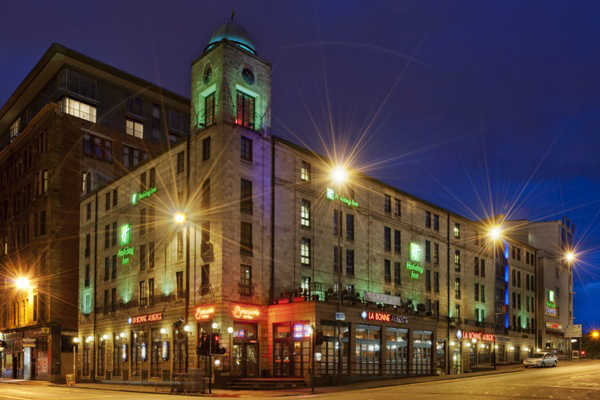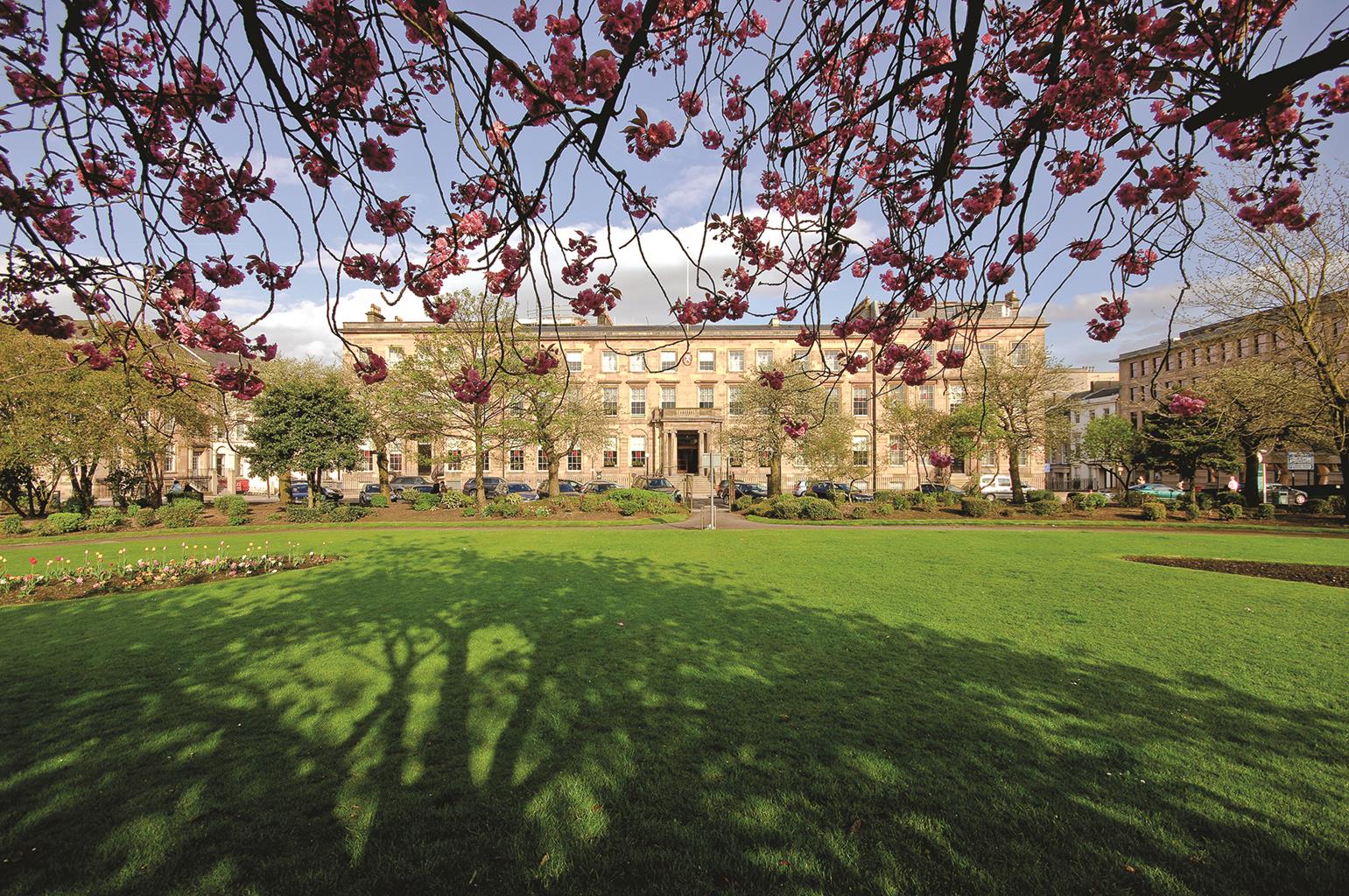The Holiday Inn Glasgow City Centre Theatreland is ideally located built on a corner site close…
Glasgow's Architecture

From the heart of the Merchant City to where it all started in the old town
2.5 miles (4kms)
About the walk
In the 18th and 19th centuries, Glasgow was a growing and prosperous city as the profits from tobacco, sugar and textiles built some of the finest buildings in the land. By the time of the two Great Exhibitions of 1888 and 1901, Glasgow was recognised as the second city of the Empire.
The Gallery of Modern Art, with the pediment now imaginatively decorated with primary coloured mosaic, was, in 1778, the residence of William Cunninghame, a tobacco lord, and later became the Royal Exchange. On Ingram Street is the imposing façade of the Corinthian, formerly the Union Bank. In Virginia Street are many of the buildings of the tobacco and sugar merchants of Georgian Glasgow. At No 51 is Virginia Court, where the tobacco merchants were based from 1817. It later became the home of Jacobean Corsetry, whose sign can still be seen on the wall. Nos 32-35 were the former Tobacco Exchange and then the Sugar Exchange, now converted into shops and apartments.
The white square building with the spire at the junction of Hutcheson Street and Ingram Street is Hutcheson’s Hall. It was a hospital built in 1805 with the legacy of George and Thomas Hutcheson. It is now in the care of National Trust. The Hutchesons left the money to build a hospital for the elderly and a school for poor orphans. The school, Hutcheson’s Grammar, also still exists, although it is now a fee-paying private school.
Also on Ingram Street is the Ramshorn Church, now used as a theatre by Strathclyde University. It was St David’s Parish Church, but was known as the Ramshorn because of the legend that St Mungo turned a stolen ram’s head into stone on this spot.
Medieval Glasgow
Moving back in time, the High Street was the ancient centre of Glasgow and around the Cathedral Gardens are some of the city’s oldest buildings. Provand’s Lordship is the oldest house in Glasgow, built around 1471 for the priest in charge of the St Nicholas Hospital. It later became the house of the Canon of Barlanark, rector of the Lordship of Provan. The house has had many uses but somehow survived the centuries to become a museum. Opposite Provand’s Lordship is the medieval Glasgow Cathedral, on the site of previous places of worship, dating back to the founding of Glasgow, when St Mungo first established his cell beside the Molendinar Burn in the 6th century. It is a fine example of medieval architecture, and the only mainland cathedral to have escaped the ravages of the Reformation. Deep within the building, which is more ornate than its stark exterior would suggest, is the tomb of St Mungo, surrounded by four columns supporting fan vaulting.
Walk directions
From Queen Street Station head down Queen Street, past George Square and turn right into the Gallery of Modern Art, once the mansion of a tobacco lord. Exit the museum and cross into Ingram Street.
Go along Ingram Street past the imposing façade of the Corinthian. It is well worth making a stop here to see the ornate interior of the grandest pub in the city. Then turn right into Virginia Place leading to Virginia Street, where you can admire more of the buildings of the tobacco merchants.
From Virginia Street, turn left into Trongate, left into Hutcheson Street and then right into Ingram Street at Hutcheson’s Hall. Go along Ingram Street past the Ramshorn Church to the junction with the High Street.
Turn left uphill to the Cathedral Square Gardens on the right. Around this pedestrian area you can see St Mungo Museum of Religious Life, Provand’s Lordship and Glasgow Cathedral. When you have finished exploring here, cross the road to Cathedral Street.
Go along Cathedral Street, passing a number of Strathclyde University buildings and turn left into Montrose Street. When you reach George Square, turn left and walk along to the entrance to the City Chambers.
Leave the City Chambers and cross the road to George Square. As you wander across George Square to return to the start of the walk, stop and look back to get a view of the rich ornamentation of the City Chambers.
Additional information
City pavements
City streets
Not a great walk for dogs
AA Street by Street Glasgow
Buchanan Galleries (There is parking at Queen Street Station but not much)
Queen Street Station
WALKING IN SAFETY
Read our tips to look after yourself and the environment when following this walk.
Find out more
Also in the area
About the area
Discover Glasgow
Scotland’s biggest city is also arguably its youngest. Glasgow may have been founded some 1,500 years ago, but most of what you see today is much more recent. The nightlife is legendary, ranging from a lively clubbing scene to Scottish traditional music in lively bars and pubs. The city claims to be Scotland’s sporting capital, a claim which was reinforced when it was chosen to host the 2014 Commonwealth Games. Football is as much a local obsession as anywhere in Scotland, with all clubs maintaining a keen rivalry.
Glasgow can claim to be one of Scotland’s most ethnically diverse cities, and it has been since the 19th century. Glasgow’s industrial boom created huge demand for labour at a time when both the Scottish Highlands and Ireland were suffering extreme poverty and even famine, so tens of thousands of people migrated to work in Glasgow’s mills and shipyards. The city also had a sizeable Jewish community, and in the late 19th century, large numbers of Italians migrated to the city. About a century later, Glasgow attracted migrants from India, Pakistan and Bangladesh, and as a result you’ll find some of the best Asian food in Scotland here.
Nearby stays
Restaurants and Pubs
Nearby experiences
Recommended things to do
Why choose Rated Trips?
Your trusted guide to rated places across the UK
The best coverage
Discover more than 15,000 professionally rated places to stay, eat and visit from across the UK and Ireland.
Quality assured
Choose a place to stay safe in the knowledge that it has been expertly assessed by trained assessors.
Plan your next trip
Search by location or the type of place you're visiting to find your next ideal holiday experience.
Travel inspiration
Read our articles, city guides and recommended things to do for inspiration. We're here to help you explore the UK.
















